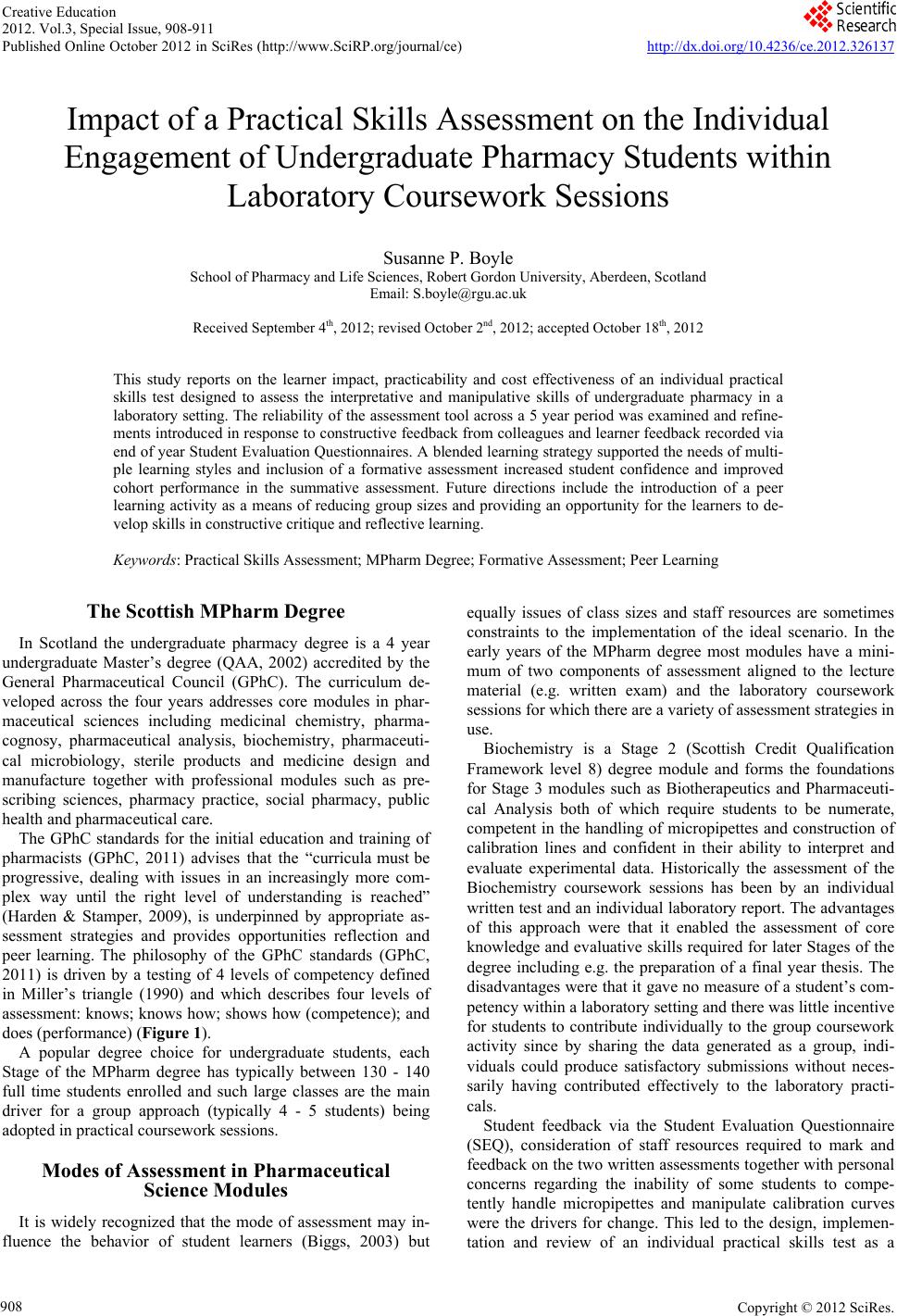
Creative Education
2012. Vol.3, Special Issue, 908-911
Published Online October 2012 in SciRes (http://www.SciRP.org/journal/ce) http://dx.doi.org/10.4236/ce.2012.326137
Copyright © 2012 SciRes.
908
Impact of a Practical Skills Assessment on the Individual
Engagement of Undergraduate Pharmacy Students within
Laboratory Coursework Sessions
Susanne P. Boyle
School of Pharmacy and Life Sciences, Robert Gordon University, Aberdeen, Scotlan d
Email: S.boyle@rgu.ac.uk
Received September 4th, 2012; revised October 2nd, 2012; accepted October 18th, 2012
This study reports on the learner impact, practicability and cost effectiveness of an individual practical
skills test designed to assess the interpretative and manipulative skills of undergraduate pharmacy in a
laboratory setting. The reliability of the assessment tool across a 5 year period was examined and refine-
ments introduced in response to constructive feedback from colleagues and learner feedback recorded via
end of year Student Evaluation Questionnaires. A blended learning strategy supported the needs of multi-
ple learning styles and inclusion of a formative assessment increased student confidence and improved
cohort performance in the summative assessment. Future directions include the introduction of a peer
learning activity as a means of reducing group sizes and providing an opportunity for the learners to de-
velop skills in constructive critique and reflective learning.
Keywords: Practical Skills Assessment; MPharm Degree; Formative Assessment; Peer Learning
The Scottish MPharm Degree
In Scotland the undergraduate pharmacy degree is a 4 year
undergraduate Master’s degree (QAA, 2002) accredited by the
General Pharmaceutical Council (GPhC). The curriculum de-
veloped across the four years addresses core modules in phar-
maceutical sciences including medicinal chemistry, pharma-
cognosy, pharmaceutical analysis, biochemistry, pharmaceuti-
cal microbiology, sterile products and medicine design and
manufacture together with professional modules such as pre-
scribing sciences, pharmacy practice, social pharmacy, public
health and pharmaceutical care.
The GPhC standards for the initial education and training of
pharmacists (GPhC, 2011) advises that the “curricula must be
progressive, dealing with issues in an increasingly more com-
plex way until the right level of understanding is reached”
(Harden & Stamper, 2009), is underpinned by appropriate as-
sessment strategies and provides opportunities reflection and
peer learning. The philosophy of the GPhC standards (GPhC,
2011) is driven by a testing of 4 levels of competency defined
in Miller’s triangle (1990) and which describes four levels of
assessment: knows; knows how; shows how (competence); and
does (performance) (Figure 1).
A popular degree choice for undergraduate students, each
Stage of the MPharm degree has typically between 130 - 140
full time students enrolled and such large classes are the main
driver for a group approach (typically 4 - 5 students) being
adopted in practical coursework sessions.
Modes of Assessment in Pharmaceutical
Science Modules
It is widely recognized that the mode of assessment may in-
fluence the behavior of student learners (Biggs, 2003) but
equally issues of class sizes and staff resources are sometimes
constraints to the implementation of the ideal scenario. In the
early years of the MPharm degree most modules have a mini-
mum of two components of assessment aligned to the lecture
material (e.g. written exam) and the laboratory coursework
sessions for which there are a variety of assessment strategies in
use.
Biochemistry is a Stage 2 (Scottish Credit Qualification
Framework level 8) degree module and forms the foundations
for Stage 3 modules such as Biotherapeutics and Pharmaceuti-
cal Analysis both of which require students to be numerate,
competent in the handling of micropipettes and construction of
calibration lines and confident in their ability to interpret and
evaluate experimental data. Historically the assessment of the
Biochemistry coursework sessions has been by an individual
written test and an individual laboratory report. The advantages
of this approach were that it enabled the assessment of core
knowledge and evaluative skills required for later Stages of the
degree including e.g. the preparation of a final year thesis. The
disadvantages were that it gave no measure of a student’s com-
petency within a laboratory setting and there was little incentive
for students to contribute individually to the group coursework
activity since by sharing the data generated as a group, indi-
viduals could produce satisfactory submissions without neces-
sarily having contributed effectively to the laboratory practi-
cals.
Student feedback via the Student Evaluation Questionnaire
(SEQ), consideration of staff resources required to mark and
feedback on the two written assessments together with personal
concerns regarding the inability of some students to compe-
tently handle micropipettes and manipulate calibration curves
were the drivers for change. This led to the design, implemen-
tation and review of an individual practical skills test as a